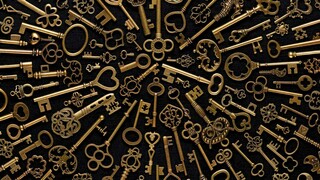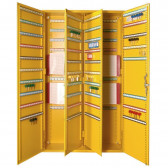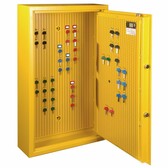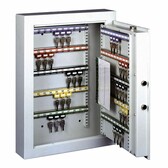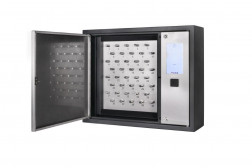Despite the increasing prevalence of electronic access controls, there is still a need to manage a large number of keys in many institutions. Such places include production facilities, medical care facilities and schools. At the same time, there are industries where keys as such are an element of value such that they must be guarded diligently, for instance car keys. How do you go about storing keys and what should one choose?
Advantages of key cabinets
The easiest way to store keys is with key cabinets. They are available in our range in many sizes and are equipped with a large number of hooks on which the numbered keys rest.
Cabinets of this type are hung on a wall. The method of mounting the box on the wall is very simple, steel anchors are sufficient.
Key cabinets are simple and lightweight products, designed to store keys in an orderly rather than an anti-burglary mode, to manage keys rather than guard them against break-ins.
Key cabinets are usually fitted with a key lock, although models that have an electronic lock are also available.
Uses for key safes
If you are looking for something to store keys of greater importance, such as car keys or keys to strategically important rooms, you should review key safes instead of a lightweight cabinet.
A key safe is already an anti-burglary device, the resistance of which is confirmed by at least an EN 14450 class S1 certificate.
Key safes are used wherever you are genuinely concerned about attempted break-ins, or where the loss of keys will be a major problem for you.
These units have stronger, sometimes multi-walled doors and walls. There are also products available that are designed to be built into the wall, although you can hang or place such a safe in many places.
Key safes, like cabinets, can be fitted with a key lock, combination lock or electronic lock.
Also read the article: Is it worth having a key safe?
How do key depositaries work?
For the most discerning customers, we offer more advanced devices that are used not just for storage, but for efficient key management, including controlling access to and the flow of keys.
The key depository operates over the Internet. The door is opened and the key-holding socket is released after a positive verification of a user, which is done using a code, a card or a combination of both.
Despite appearances, a key depositary is an easy way to work with keys. Remember, however, that depositories are not key safes and do not, by themselves, provide burglary protection. It is therefore best that they work alongside other security methods, such as 24-hour monitoring and security.
You can read more about these products in the article: Key cabinets – when is it worth buying them?
Which key safes to buy?
Ultimately, you have to decide for yourself whether your needs will be sufficiently met by cabinets, key safes or depositories designed for key management. All of these are available in different sizes and capacities, and you will need to choose the type of lock and the place of installation.
If you have any doubts or questions, please do not hesitate to contact us. Our Sales Department advisors will be happy to help you find the right solution.
